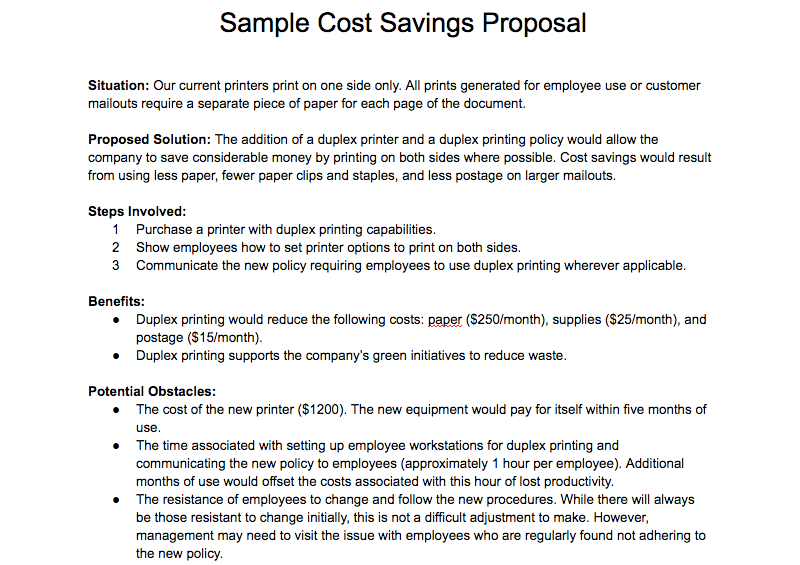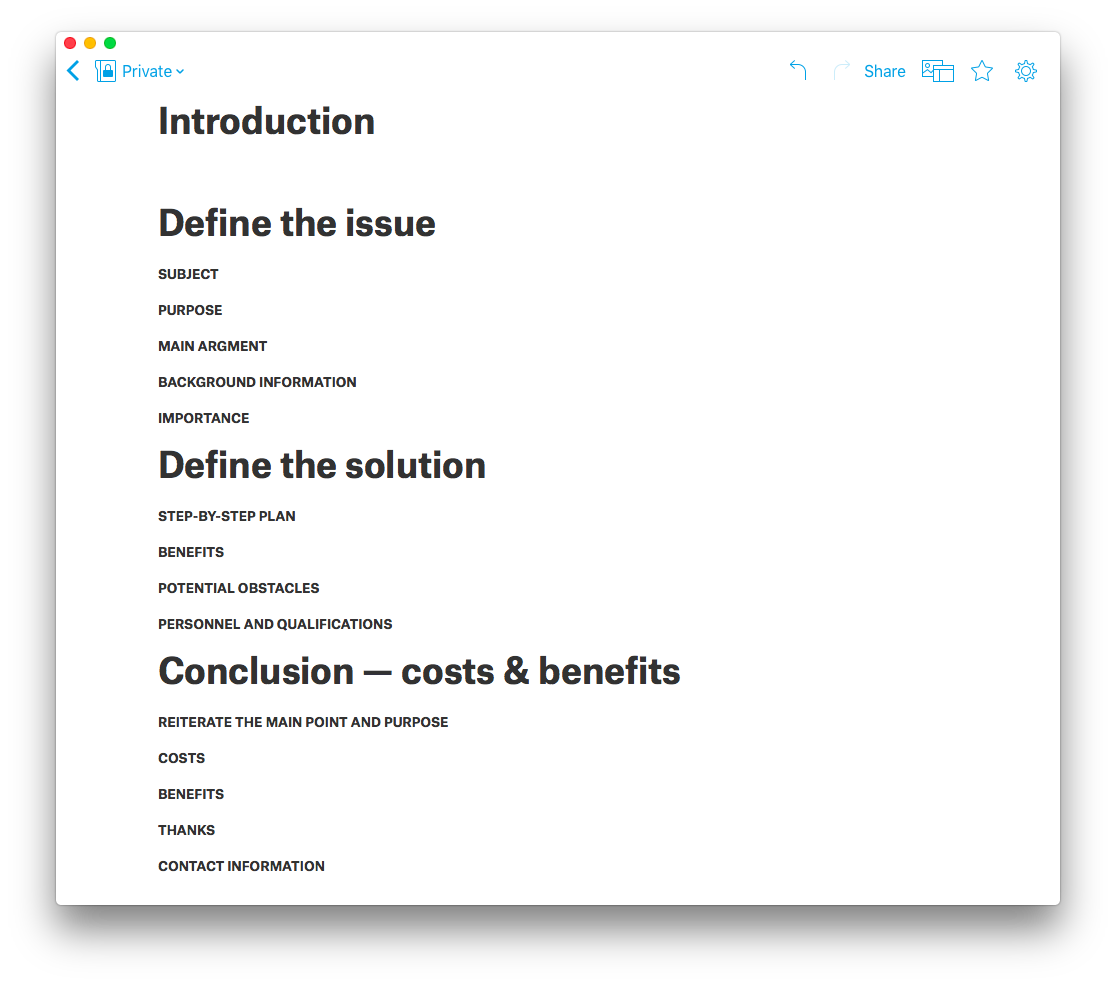A proposal has a lot of different purposes, but there’s only one good way to write one: the way that pulls together all of the information in a concise and persuasive way and helps you get what you want … whether that’s a whole new software system, or just a tweak to your marketing strategy.
This Process Street article isn’t about a business proposal — also known as a quote — but instead about the document required when formally pitching an idea for action and execution by managers or department heads.
To explain how to write a proposal document and get what you want, we’ll go through the following:
- Free proposal writing template
- When are proposals necessary?
- Why are proposals important?
- Examples of proposals
- How to write a proposal: step-by-step
- Last steps before submitting the proposal
- More free proposal writing checklists
- Even more free proposal writing checklists
- Customize your proposal checklists with Process Street
Free proposal writing template
If you fancy taking a quick look at a free interactive template, that will help you write your proposals right away, feel free to dive straight into this!
Writing a Proposal: Step-by-Step Guide
There are more templates, like this one, further down in this post, so stick around.
When are proposals necessary?
Any project you don’t have the clearance or authority to start without a higher-up’s approval, you need to submit a proposal for.
According to SSWM, a proposal is “a detailed description of a series of activities aimed at solving a certain problem”.
That problem could be anything, from:
- Process improvement
- Cost reduction
- A new marketing strategy
If it’s an idea you need to ask permission to execute, or to get action on, it needs a proposal.
Why are proposals important?
A proposal is a way to pitch an idea and state your requirements, so it’s important for supervisors because they can get information in writing (not casually in the elevator), and be able to act knowing the full implications of their decision.
They’re also a chance for you to make a structured, logical argument and lay down everything in favor of your idea. A well-written proposal shows your manager you care about the cause, and it’s not just a mid-meeting whim you blurted out.
To write a top proposal you need to scrutinize it before you present it.
Examples of proposals
It’s a broad topic, but it’s best explained with examples.
Below is a simple proposal example with some basic sections.

Now let’s take a look at how to write a proposal — whether it’s as simple as the one above, or more complex.
How to write a proposal: step-by-step
Here’s the general structure of a proposal:

As you can see, a proposal generally consists of:
- Introduction: A brief overview of the problem, solution, costs, and benefits.
- Issue: The main definition of the issue, including subject, purpose, main argument, background information and importance.
- Solution: The main definition of the solution, including your step-by-step plan, the benefits, and how potential obstacles will be overcame.
- Qualifications: Overview of the personnel required, experience.
- Conclusion of the costs and benefits, and wrap-up: Balance the cost against the benefit, reinforce your point one last time.
1. Identify and define your reader
Just like with any kind of persuasion, it helps if you understand how to appeal to your audience. Who will be reading your proposal and deciding if it’s accepted or rejected? What do they care about? What kind of language and benefits would resonate with them? This is the first step because it’s an important thing to keep in mind as you go along and as information that informs the way you write from here on.
2. Define the problem your proposal will solve
Who: Who will the proposal affect?
What: What’s the reason for you to write the proposal in the first place? Explain the current situation and the problems that come with it.
3. Define the solution
How: How are you going to solve the problem? Explain step-by-step in detail.
Who: Identify the personnel you need, along with their prior experience to add persuasion to the proposal
4. Conclusion: costs, benefits and wrap-up
Reiterate: The purpose and main argument
Costs: Break down the projected costs involved for different elements of the project
Benefits: Break down the benefits to the organization, monetary and non-monetary, to persuade the reader there’ll be a return on investment
Thanks: Thank the reader for their time.
Contact information: Where can the reader get in touch with you? Make sure to be crystal clear to make the details easily discoverable.
Last steps before submitting the proposal
Clear writing is your best friend when you’re trying to write persuasively. For that reason, there are a few checks to run before you submit your proposal.
Remember, what’s clear to you might not always be clear to other people.
1 .Check for jargon (then destroy it)
Although jargon is popular in the business world, not everyone shares the equal love for it. It’s terms like right-size, blue sky (verb), turn-key, and synergize. They might mean something to you, or make you feel intelligent, but there are simpler alternatives that will help people understand what you mean!
2. Change the passive voice to the active voice
The passive voice is defined as:
“The noun or noun phrase that would be the object of an active sentence (such as Our troops defeated the enemy) appears as the subject of a sentence with passive voice (e.g. The enemy was defeated by our troops).”.
It’s a long-winded way of expressing something that could be expressed in simple terms:

The passive voice sounds distant and even deceptive, and, since the reader might even just be skimming your proposal, you don’t want to add extra words to cloud your point.
3. Proofread the proposal
Install a tool like Grammarly and check the proposal in an online text editor. Grammarly will manage to pick up on anything that is grammatically incorrect and sometimes even flags up stylistically poor phrases. Poor spelling and grammar will only discredit the value of what you’re saying and could be a problem that leads to your proposal being rejected.
More free proposal writing checklists
As promised, check out the below five templates that have each been designed by the team at Process Street — makers of the finest remote work software for processes around — to help you write winning proposals.
Proposal Template Checklist Process
This proposal template is a checklist that should be used alongside the proposal document you are planning to submit. Use it to make sure that all the elements have been considered, that the proposal contains everything it needs to and that it meets all set requirements.
Click here to access the Proposal Template Checklist Process!
Business Proposal Template Checklist
Whether your business proposal is solicited or unsolicited, use this business proposal template checklist to ensure you include all the required information in your proposal and cover key areas such as these the problem the organization is facing, the proposed solution, the budget, and a key CTA.
Click here to access the Business Proposal Template Checklist!
How to Write a Grant Proposal Checklist
Use this template to make sure your grant proposal includes all the relevant information, that it contains everything it needs to, and that it meets all stated RFP requirements.
Click here to access the How to Write a Grant Proposal Checklist!
Research Proposal Example Checklist
Use this template to convince others that you have a worthwhile research project and that you have the competence and the work-plan to complete it.
Click here to access the Research Proposal Example Checklist!
Project Proposal Template Checklist
Use this template, alongside the proposal document you are planning to submit, to set the project vision, define the project requirements, describe the deliverables, and specify the deadlines.
Click here to access the Project Proposal Template Checklist!
Even more free proposal writing checklists
If you’re looking for more inspiration, give these alternative proposal writing templates a go too.
- Bid Proposal Template Checklist
- Budget Proposal Template
- Construction Proposal Template Checklist
- Consulting Proposal Template Checklist
- Continuation Project Proposal Template
- Contractor Proposal Template Checklist
- Event Proposal Template Checklist
- Marketing Proposal Template Checklist
- Project Proposal Template
- Renewal Project Proposal Template
- Simple Proposal Format Checklist
- Sponsorship Proposal Template Checklist
- Supplemental Project Proposal Template
- Website Proposal Template Checklist
Customize your proposal checklists with Process Street
If the above templates don’t quite fit your company, industry, or the proposal document you are writing, don’t worry!
Process Street to the rescue!
Process Street is super-powered checklists. We are a super-charged, state of the art BPM SaaS platform which allows you to create templates and run individual checklists from these. You can check tasks off as you work through them, set deadlines, request approvals, assign various tasks, and work through your proposal workflows with ease.
Watch this to get an idea about who we are and what we do:
To help you customize your proposal writing template, and make your proposal wriitng easier, you can use all these different types of Process Street features:
- Stop tasks
- Dynamic due dates
- Task permissions
- Conditional logic
- Approval tasks
- Embed widget
- Role assignments
You can also connect your templates to thousands of apps through Zapier, webhooks, or API access to automate your proposal processes and workflows.
If you’re unfamiliar with process automation, what it means, and the benefits it can bring to your business, watch this Process Street webinar on automation:
Remember, if you want to get access to any of our proposal writing checklists, just click the links above and they will be added to your Process Street account where you can use them over and over again. Or, if you haven’t yet signed up for a Process Street account, click here and start your free trial.
Has this guide helped you out? I’d love to hear about it in the comments.







 Workflows
Workflows Projects
Projects Data Sets
Data Sets Forms
Forms Pages
Pages Automations
Automations Analytics
Analytics Apps
Apps Integrations
Integrations
 Property management
Property management
 Human resources
Human resources
 Customer management
Customer management
 Information technology
Information technology




Benjamin Brandall
Benjamin Brandall is a content marketer at Process Street.